South Texas Wildlife Photo Tour
May 2014
Trip Report
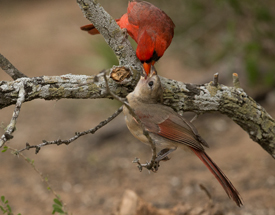
Cardinal feeding juvenile
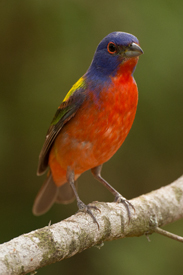
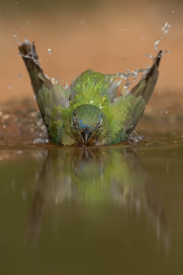
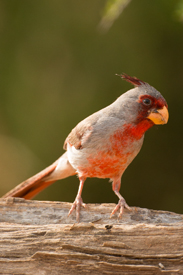

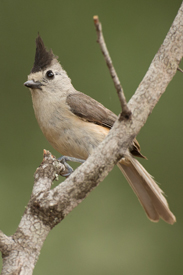
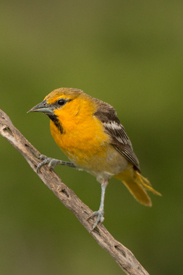
Top: Painted Bunting male, female bathing; Pyrrhuloxia
Bottom: Scissor-tailed Flycatcher; Black-crested Titmouse;
Bullock's Oriole
Pictures tell a thousand words, so the Photos included here will tell you as much about this tour as the write-up, but I hope you'll enjoy both!
We will be offering this tour in May, 2015
Interested? Please read the Brochure.
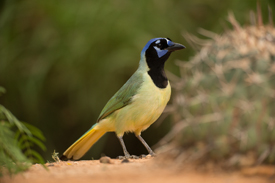
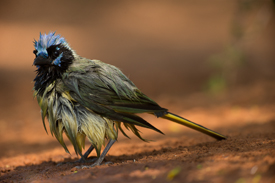


Green Jays, one of the 'trophy' species. The one in the upper right just bathed, and was the ugliest jay we saw! Of course, when it fluffed out it was gorgeous. We photographed these jays at all three ranches.
Many, many years ago, Mary and I participated in one of the Texas Valley Land Fund Photo Contests. We loved the experience, did very well in the contest, and hoped, at some point, to return to the area. Last year, we did an extremely brief 'scouting trip' where we spent less than 2 full days at two ranches where we hoped to visit for a 2014 trip. Which we did, this year, with wonderful results. The trip met almost all of my expectations, with the exception of photographing nocturnal wildlife, which was due to the 'iffy' weather and wind that precluded setting up camera traps each night.
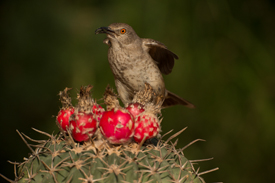
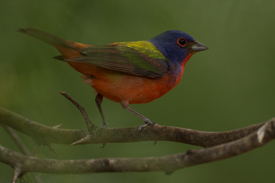
Curve-billed Thrasher; Painted Bunting
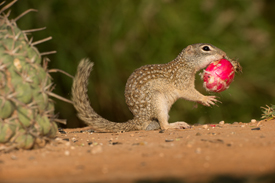
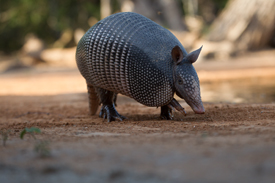
Mexican Ground squirrel; the Armadillo that walked within6 feet of our blind.
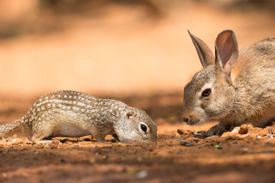
.jpg)
A second later, the ground squirrel and rabbit touched noses, and I missed it!
Texas Horned Lizards, when I was a kid, was a popular pet, sold in pet stores all over the country. They never did well, as they mostly eat ants. When Argentinean red ants invaded the south, the ants have ravaged the population of this cute, harmless lizard. At our third ranch, we were told they'd seen only five of these lizards here!
Our trip began with a rather rushed packing from our two photo tours in southern Arizona, where we had to tear down, organize and pack our truck for the 1.5 day drive to south Texas. Since I was just 11 weeks post major back surgery, packing was difficult, although I was helped immensely by my friend, Christian Cunha, in packing the truck. I was also assisted on that trip by Tom Wester, my other great friend, so our Arizona experience went fairly effortlessly for me ... although I was exhausted by the end of most days. But that's another Trip Report!
We stayed at two different ranches, and visited three -- with one of our two ranches serving as the base for our visits to that ranch and another, adjacent ranch about 6 miles further north. Using three different ranches, we had the luxury of enjoying multiple photo blinds, with some offering above ground photo blinds and others sunken into the earth, providing almost ground or water level perspectives. When Mary and I did our usual recap of the trip with the participants, everyone felt that all three ranches had something unique and great to offer, with enough variety and perspectives that they had no suggestions for changing the itinerary. We love that type of feedback!
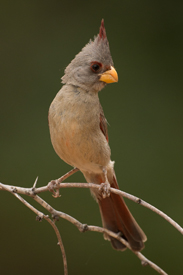
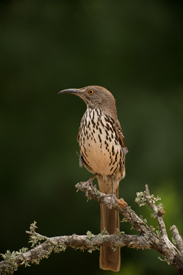
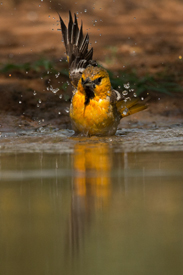


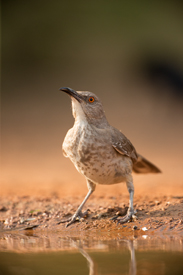
Top: Pyrrhuloxia female; Long-billed Thrasher; Bullock's Oriole
Bottom: Crested Caracara; Golden-fronted Woodpecker; Curve-billed Thrasher
The group photographed at least 41 different species of birds, and perhaps a few more that I'm not aware of. These included great opportunities for Roadrunners (many folks personal favorite), Painted Buntings, Crested Caracaras, and multiple finches, thrushes, and quail. Mammals were less common, although Mexican Ground Squirrels were abundant and fun, and 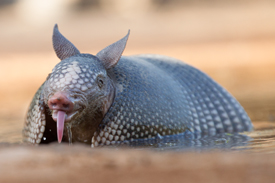 we had some luck with Whitetail Deer and two surprisingly delightful encounters with Nine-banded Armadillos. The first of these suddenly appeared at our photo blind, crashed into the pool just a few yards from our blind, and rolled and wallowed in the water before climbing out and scurrying by, just a few feet from our lenses! The next day, just as Mary and Libby were closing up for the day, the armadillo appeared again, drinking at the waterhole and ignoring them as they frantically dug out gear for more shooting.
we had some luck with Whitetail Deer and two surprisingly delightful encounters with Nine-banded Armadillos. The first of these suddenly appeared at our photo blind, crashed into the pool just a few yards from our blind, and rolled and wallowed in the water before climbing out and scurrying by, just a few feet from our lenses! The next day, just as Mary and Libby were closing up for the day, the armadillo appeared again, drinking at the waterhole and ignoring them as they frantically dug out gear for more shooting.
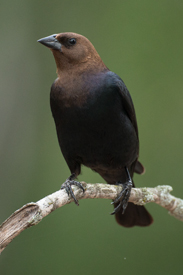
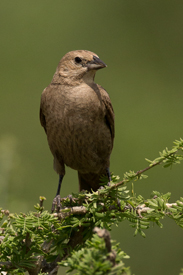
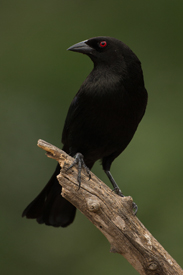


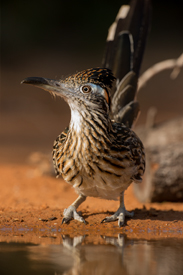
Top: Brown-headed Cowbird, male and female; Bronzed Cowbird
Bottom: Bronzed Cowbird hovering in the 'helicopter flight' display;
Red-winged Blackbird; Greater Roadrunner

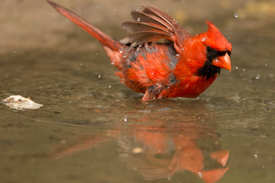
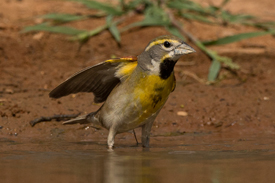
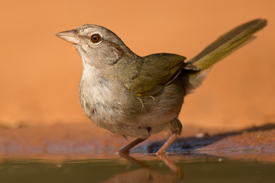
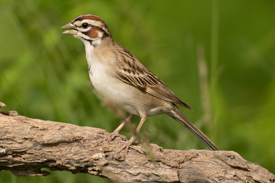

Top: Northern Cardinal
Middle: Dickcissel; Olive Sparrow
Bottom: Lark Sparrow; Black-throated Sparrow
At one ranch, two different Whitetail Deer cautiously approached the waterhole and our blinds. The first time, the three of us in the blind sat quietly, waiting for the doe to move in to drink. We photographed her as she approached, and then, to everyone's credit, we stopped shooting, hoping that she'd move in the final few yards to drink. She didn't, and instead walked off. Although we didn't photograph her drinking, it was a truly wonderful experience to watch. The next afternoon, I scouted out one of the 'morning' blinds to see if a visit in the afternoon -- when the sun is shining into the blind, and backlighting the wildlife -- would be worth doing in the  future. The light was harsh much of the time, as the afternoon clouds that promised to make the venture worthwhile dissipated for most of the visit. Still, a velvet buck suddenly appeared at the waterhole, and I was treated to a water level view as the buck drank, then circled the waterhole, and drank again. Being so close that I had to zoom back with a 300mm lens was a real treat and thrill, and I can just imagine if the hoped-for Javelinas or Bobcats had done the same. Last year, on our scouting trip, we did have Javelina, but this year we did not -- but that's nature!
future. The light was harsh much of the time, as the afternoon clouds that promised to make the venture worthwhile dissipated for most of the visit. Still, a velvet buck suddenly appeared at the waterhole, and I was treated to a water level view as the buck drank, then circled the waterhole, and drank again. Being so close that I had to zoom back with a 300mm lens was a real treat and thrill, and I can just imagine if the hoped-for Javelinas or Bobcats had done the same. Last year, on our scouting trip, we did have Javelina, but this year we did not -- but that's nature!
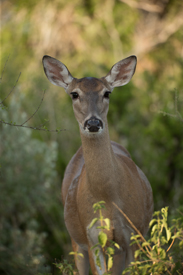
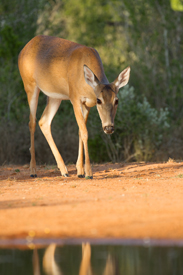
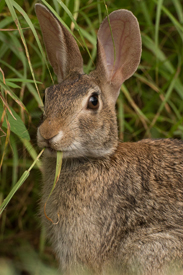
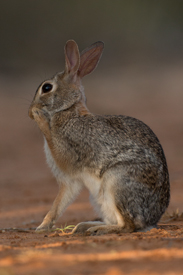
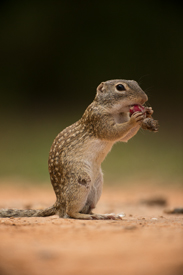
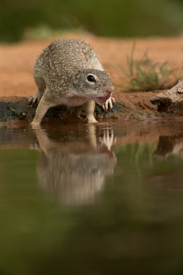
Top: Whitetailed Deer; Desert Cottontail
Bottom: Desert Cottontail; Mexican Ground squirrel
One of the real attractions to these locations is the very real fact that a 400mm or 500mm lens is perfect for photographing the birds -- you are that close. I was using an 800mm (I bought it last year after the snow leopard trip and decided to justify the expense whenever I could!) and I was often challenged to fit a bird within the frame. Without using a 25mm extension tube, I'd have been out of luck much of the time as the birds were within the minimum focus of the lens.
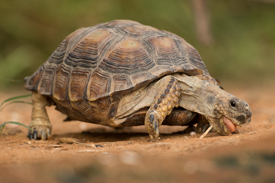 Perhaps my personal highlight was a Texas Gopher Tortoise that visited one of the water holes, strolling about and almost going into the water for a soak. Interestingly, the Tortoise appeared to be attempting to lick ants from the sand, as several times it opened its mouth and extended its tongue to the sand. Ants were moving all about, and I could believe that it was trying to extract some animal protein, although my initial views did not show any ants adhering to the tongue. Still, if it was doing this, this is behavior I've never read or heard about before, and illustrates the wonderful opportunities one has sitting in these blinds and letting the wildlife show go on about you.
Perhaps my personal highlight was a Texas Gopher Tortoise that visited one of the water holes, strolling about and almost going into the water for a soak. Interestingly, the Tortoise appeared to be attempting to lick ants from the sand, as several times it opened its mouth and extended its tongue to the sand. Ants were moving all about, and I could believe that it was trying to extract some animal protein, although my initial views did not show any ants adhering to the tongue. Still, if it was doing this, this is behavior I've never read or heard about before, and illustrates the wonderful opportunities one has sitting in these blinds and letting the wildlife show go on about you.
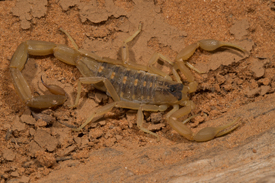
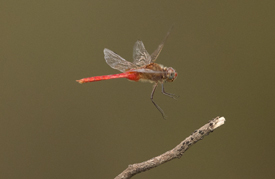
Because of my back I wasn't enthusiastic about lying down to photograph insects, and so I passed up several opportunities for shooting wonderful Tarantulas I saw on several nights. The owner of one of the ranches, upon discovering a Scorpion in a black widow spider's web, plucked the scorpion from the web by holding its tail and placed the still-living scorpion in a jar for us. I was amazed! At most of the water holes, Dragonflies flit about, and at one I challenged myself to catch a dragonfly as it would land upon a stick. Next year, I hope the group will be doing this using my high speed flashes!
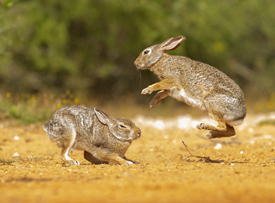 This, in fact, was one of the highlights for everyone -- the closeness and intimacy we had, being so near to wildlife that completely ignored us. Desert Cottontail Rabbits drank at all of our water holes, and at two blinds the rabbits engaged in spats where they reared, boxed, and jumped about in a show of dominance.
This, in fact, was one of the highlights for everyone -- the closeness and intimacy we had, being so near to wildlife that completely ignored us. Desert Cottontail Rabbits drank at all of our water holes, and at two blinds the rabbits engaged in spats where they reared, boxed, and jumped about in a show of dominance.
We'll be doing two back-to-back Photo Tours to these three ranches again next year, at the conclusion of our Arizona Photo Tours, and I'm already anxious and excited about the possibilities. I'm hoping that the weather will cooperate and, honestly, that I'll be back to my old energy for doing night sets for bobcats, etc., weather permitting. I did so this year, but I was cooked by the end of the day and the effort was a struggle. But the promise, or potential, of a bobcat or coyote or javelina at a waterhole, with its reflection, too, in a well-lit flash set at night ... I just can't wait!
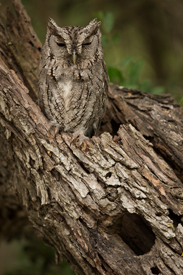
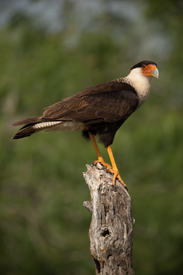

Eastern Screech Owl; Crested Caracara; Scaled Quail
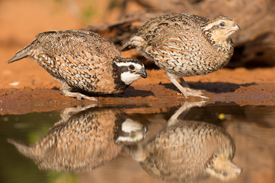
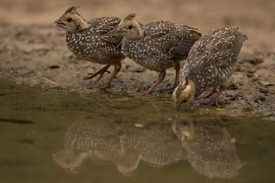
Bobwhite Quail; Scaled Quail


Scaled Quail; Groove-billed Ani
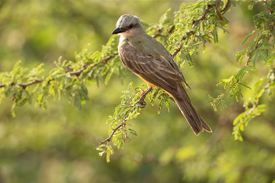

Couch's Kingbird; Eastern Wood Pewee
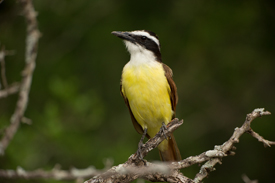

Great Kiskadee; Black-crested Titmouse
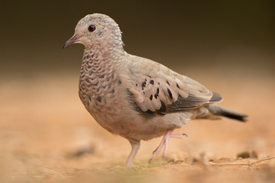
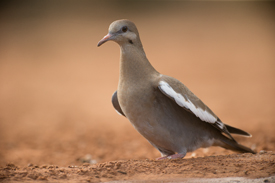
Common Ground-Dove; White-winged Dove
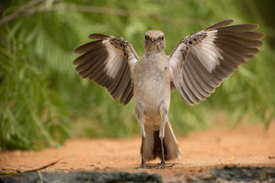

Northern Mockingbird; Long-billed Thrasher
If you're interested in joining us next year, please contact our office and get on our First Contact List for next year. We'll only be taking 6 participants, so if you're interested, please don't delay.
Contact our office at info@hoothollow.com.
South Texas Wildlife Photo Tour
May 2014
Trip Report

Cardinal feeding juvenile






Top: Painted Bunting male, female bathing; Pyrrhuloxia
Bottom: Scissor-tailed Flycatcher; Black-crested Titmouse;
Bullock's Oriole
Pictures tell a thousand words, so the Photos included here will tell you as much about this tour as the write-up, but I hope you'll enjoy both!
We will be offering this tour in May, 2015
Interested? Please read the Brochure.




Green Jays, one of the 'trophy' species. The one in the upper right just bathed, and was the ugliest jay we saw! Of course, when it fluffed out it was gorgeous. We photographed these jays at all three ranches.
Many, many years ago, Mary and I participated in one of the Texas Valley Land Fund Photo Contests. We loved the experience, did very well in the contest, and hoped, at some point, to return to the area. Last year, we did an extremely brief 'scouting trip' where we spent less than 2 full days at two ranches where we hoped to visit for a 2014 trip. Which we did, this year, with wonderful results. The trip met almost all of my expectations, with the exception of photographing nocturnal wildlife, which was due to the 'iffy' weather and wind that precluded setting up camera traps each night.


Curve-billed Thrasher; Painted Bunting


Mexican Ground squirrel; the Armadillo that walked within6 feet of our blind.

.jpg)
A second later, the ground squirrel and rabbit touched noses, and I missed it!
Texas Horned Lizards, when I was a kid, was a popular pet, sold in pet stores all over the country. They never did well, as they mostly eat ants. When Argentinean red ants invaded the south, the ants have ravaged the population of this cute, harmless lizard. At our third ranch, we were told they'd seen only five of these lizards here!
Our trip began with a rather rushed packing from our two photo tours in southern Arizona, where we had to tear down, organize and pack our truck for the 1.5 day drive to south Texas. Since I was just 11 weeks post major back surgery, packing was difficult, although I was helped immensely by my friend, Christian Cunha, in packing the truck. I was also assisted on that trip by Tom Wester, my other great friend, so our Arizona experience went fairly effortlessly for me ... although I was exhausted by the end of most days. But that's another Trip Report!
We stayed at two different ranches, and visited three -- with one of our two ranches serving as the base for our visits to that ranch and another, adjacent ranch about 6 miles further north. Using three different ranches, we had the luxury of enjoying multiple photo blinds, with some offering above ground photo blinds and others sunken into the earth, providing almost ground or water level perspectives. When Mary and I did our usual recap of the trip with the participants, everyone felt that all three ranches had something unique and great to offer, with enough variety and perspectives that they had no suggestions for changing the itinerary. We love that type of feedback!






Top: Pyrrhuloxia female; Long-billed Thrasher; Bullock's Oriole
Bottom: Crested Caracara; Golden-fronted Woodpecker; Curve-billed Thrasher
The group photographed at least 41 different species of birds, and perhaps a few more that I'm not aware of. These included great opportunities for Roadrunners (many folks personal favorite), Painted Buntings, Crested Caracaras, and multiple finches, thrushes, and quail. Mammals were less common, although Mexican Ground Squirrels were abundant and fun, and  we had some luck with Whitetail Deer and two surprisingly delightful encounters with Nine-banded Armadillos. The first of these suddenly appeared at our photo blind, crashed into the pool just a few yards from our blind, and rolled and wallowed in the water before climbing out and scurrying by, just a few feet from our lenses! The next day, just as Mary and Libby were closing up for the day, the armadillo appeared again, drinking at the waterhole and ignoring them as they frantically dug out gear for more shooting.
we had some luck with Whitetail Deer and two surprisingly delightful encounters with Nine-banded Armadillos. The first of these suddenly appeared at our photo blind, crashed into the pool just a few yards from our blind, and rolled and wallowed in the water before climbing out and scurrying by, just a few feet from our lenses! The next day, just as Mary and Libby were closing up for the day, the armadillo appeared again, drinking at the waterhole and ignoring them as they frantically dug out gear for more shooting.






Top: Brown-headed Cowbird, male and female; Bronzed Cowbird
Bottom: Bronzed Cowbird hovering in the 'helicopter flight' display;
Red-winged Blackbird; Greater Roadrunner






Top: Northern Cardinal
Middle: Dickcissel; Olive Sparrow
Bottom: Lark Sparrow; Black-throated Sparrow
At one ranch, two different Whitetail Deer cautiously approached the waterhole and our blinds. The first time, the three of us in the blind sat quietly, waiting for the doe to move in to drink. We photographed her as she approached, and then, to everyone's credit, we stopped shooting, hoping that she'd move in the final few yards to drink. She didn't, and instead walked off. Although we didn't photograph her drinking, it was a truly wonderful experience to watch. The next afternoon, I scouted out one of the 'morning' blinds to see if a visit in the afternoon -- when the sun is shining into the blind, and backlighting the wildlife -- would be worth doing in the  future. The light was harsh much of the time, as the afternoon clouds that promised to make the venture worthwhile dissipated for most of the visit. Still, a velvet buck suddenly appeared at the waterhole, and I was treated to a water level view as the buck drank, then circled the waterhole, and drank again. Being so close that I had to zoom back with a 300mm lens was a real treat and thrill, and I can just imagine if the hoped-for Javelinas or Bobcats had done the same. Last year, on our scouting trip, we did have Javelina, but this year we did not -- but that's nature!
future. The light was harsh much of the time, as the afternoon clouds that promised to make the venture worthwhile dissipated for most of the visit. Still, a velvet buck suddenly appeared at the waterhole, and I was treated to a water level view as the buck drank, then circled the waterhole, and drank again. Being so close that I had to zoom back with a 300mm lens was a real treat and thrill, and I can just imagine if the hoped-for Javelinas or Bobcats had done the same. Last year, on our scouting trip, we did have Javelina, but this year we did not -- but that's nature!






Top: Whitetailed Deer; Desert Cottontail
Bottom: Desert Cottontail; Mexican Ground squirrel
One of the real attractions to these locations is the very real fact that a 400mm or 500mm lens is perfect for photographing the birds -- you are that close. I was using an 800mm (I bought it last year after the snow leopard trip and decided to justify the expense whenever I could!) and I was often challenged to fit a bird within the frame. Without using a 25mm extension tube, I'd have been out of luck much of the time as the birds were within the minimum focus of the lens.
 Perhaps my personal highlight was a Texas Gopher Tortoise that visited one of the water holes, strolling about and almost going into the water for a soak. Interestingly, the Tortoise appeared to be attempting to lick ants from the sand, as several times it opened its mouth and extended its tongue to the sand. Ants were moving all about, and I could believe that it was trying to extract some animal protein, although my initial views did not show any ants adhering to the tongue. Still, if it was doing this, this is behavior I've never read or heard about before, and illustrates the wonderful opportunities one has sitting in these blinds and letting the wildlife show go on about you.
Perhaps my personal highlight was a Texas Gopher Tortoise that visited one of the water holes, strolling about and almost going into the water for a soak. Interestingly, the Tortoise appeared to be attempting to lick ants from the sand, as several times it opened its mouth and extended its tongue to the sand. Ants were moving all about, and I could believe that it was trying to extract some animal protein, although my initial views did not show any ants adhering to the tongue. Still, if it was doing this, this is behavior I've never read or heard about before, and illustrates the wonderful opportunities one has sitting in these blinds and letting the wildlife show go on about you.


Because of my back I wasn't enthusiastic about lying down to photograph insects, and so I passed up several opportunities for shooting wonderful Tarantulas I saw on several nights. The owner of one of the ranches, upon discovering a Scorpion in a black widow spider's web, plucked the scorpion from the web by holding its tail and placed the still-living scorpion in a jar for us. I was amazed! At most of the water holes, Dragonflies flit about, and at one I challenged myself to catch a dragonfly as it would land upon a stick. Next year, I hope the group will be doing this using my high speed flashes!
 This, in fact, was one of the highlights for everyone -- the closeness and intimacy we had, being so near to wildlife that completely ignored us. Desert Cottontail Rabbits drank at all of our water holes, and at two blinds the rabbits engaged in spats where they reared, boxed, and jumped about in a show of dominance.
This, in fact, was one of the highlights for everyone -- the closeness and intimacy we had, being so near to wildlife that completely ignored us. Desert Cottontail Rabbits drank at all of our water holes, and at two blinds the rabbits engaged in spats where they reared, boxed, and jumped about in a show of dominance.
We'll be doing two back-to-back Photo Tours to these three ranches again next year, at the conclusion of our Arizona Photo Tours, and I'm already anxious and excited about the possibilities. I'm hoping that the weather will cooperate and, honestly, that I'll be back to my old energy for doing night sets for bobcats, etc., weather permitting. I did so this year, but I was cooked by the end of the day and the effort was a struggle. But the promise, or potential, of a bobcat or coyote or javelina at a waterhole, with its reflection, too, in a well-lit flash set at night ... I just can't wait!



Eastern Screech Owl; Crested Caracara; Scaled Quail


Bobwhite Quail; Scaled Quail


Scaled Quail; Groove-billed Ani


Couch's Kingbird; Eastern Wood Pewee


Great Kiskadee; Black-crested Titmouse


Common Ground-Dove; White-winged Dove


Northern Mockingbird; Long-billed Thrasher
If you're interested in joining us next year, please contact our office and get on our First Contact List for next year. We'll only be taking 6 participants, so if you're interested, please don't delay.
Contact our office at info@hoothollow.com.
South Texas Wildlife Photo Tour
May 2014
Trip Report

Cardinal feeding juvenile






Top: Painted Bunting male, female bathing; Pyrrhuloxia
Bottom: Scissor-tailed Flycatcher; Black-crested Titmouse;
Bullock's Oriole
Pictures tell a thousand words, so the Photos included here will tell you as much about this tour as the write-up, but I hope you'll enjoy both!
We will be offering this tour in May, 2015
Interested? Please read the Brochure.




Green Jays, one of the 'trophy' species. The one in the upper right just bathed, and was the ugliest jay we saw! Of course, when it fluffed out it was gorgeous. We photographed these jays at all three ranches.
Many, many years ago, Mary and I participated in one of the Texas Valley Land Fund Photo Contests. We loved the experience, did very well in the contest, and hoped, at some point, to return to the area. Last year, we did an extremely brief 'scouting trip' where we spent less than 2 full days at two ranches where we hoped to visit for a 2014 trip. Which we did, this year, with wonderful results. The trip met almost all of my expectations, with the exception of photographing nocturnal wildlife, which was due to the 'iffy' weather and wind that precluded setting up camera traps each night.


Curve-billed Thrasher; Painted Bunting


Mexican Ground squirrel; the Armadillo that walked within6 feet of our blind.

.jpg)
A second later, the ground squirrel and rabbit touched noses, and I missed it!
Texas Horned Lizards, when I was a kid, was a popular pet, sold in pet stores all over the country. They never did well, as they mostly eat ants. When Argentinean red ants invaded the south, the ants have ravaged the population of this cute, harmless lizard. At our third ranch, we were told they'd seen only five of these lizards here!
Our trip began with a rather rushed packing from our two photo tours in southern Arizona, where we had to tear down, organize and pack our truck for the 1.5 day drive to south Texas. Since I was just 11 weeks post major back surgery, packing was difficult, although I was helped immensely by my friend, Christian Cunha, in packing the truck. I was also assisted on that trip by Tom Wester, my other great friend, so our Arizona experience went fairly effortlessly for me ... although I was exhausted by the end of most days. But that's another Trip Report!
We stayed at two different ranches, and visited three -- with one of our two ranches serving as the base for our visits to that ranch and another, adjacent ranch about 6 miles further north. Using three different ranches, we had the luxury of enjoying multiple photo blinds, with some offering above ground photo blinds and others sunken into the earth, providing almost ground or water level perspectives. When Mary and I did our usual recap of the trip with the participants, everyone felt that all three ranches had something unique and great to offer, with enough variety and perspectives that they had no suggestions for changing the itinerary. We love that type of feedback!






Top: Pyrrhuloxia female; Long-billed Thrasher; Bullock's Oriole
Bottom: Crested Caracara; Golden-fronted Woodpecker; Curve-billed Thrasher
The group photographed at least 41 different species of birds, and perhaps a few more that I'm not aware of. These included great opportunities for Roadrunners (many folks personal favorite), Painted Buntings, Crested Caracaras, and multiple finches, thrushes, and quail. Mammals were less common, although Mexican Ground Squirrels were abundant and fun, and  we had some luck with Whitetail Deer and two surprisingly delightful encounters with Nine-banded Armadillos. The first of these suddenly appeared at our photo blind, crashed into the pool just a few yards from our blind, and rolled and wallowed in the water before climbing out and scurrying by, just a few feet from our lenses! The next day, just as Mary and Libby were closing up for the day, the armadillo appeared again, drinking at the waterhole and ignoring them as they frantically dug out gear for more shooting.
we had some luck with Whitetail Deer and two surprisingly delightful encounters with Nine-banded Armadillos. The first of these suddenly appeared at our photo blind, crashed into the pool just a few yards from our blind, and rolled and wallowed in the water before climbing out and scurrying by, just a few feet from our lenses! The next day, just as Mary and Libby were closing up for the day, the armadillo appeared again, drinking at the waterhole and ignoring them as they frantically dug out gear for more shooting.






Top: Brown-headed Cowbird, male and female; Bronzed Cowbird
Bottom: Bronzed Cowbird hovering in the 'helicopter flight' display;
Red-winged Blackbird; Greater Roadrunner






Top: Northern Cardinal
Middle: Dickcissel; Olive Sparrow
Bottom: Lark Sparrow; Black-throated Sparrow
At one ranch, two different Whitetail Deer cautiously approached the waterhole and our blinds. The first time, the three of us in the blind sat quietly, waiting for the doe to move in to drink. We photographed her as she approached, and then, to everyone's credit, we stopped shooting, hoping that she'd move in the final few yards to drink. She didn't, and instead walked off. Although we didn't photograph her drinking, it was a truly wonderful experience to watch. The next afternoon, I scouted out one of the 'morning' blinds to see if a visit in the afternoon -- when the sun is shining into the blind, and backlighting the wildlife -- would be worth doing in the  future. The light was harsh much of the time, as the afternoon clouds that promised to make the venture worthwhile dissipated for most of the visit. Still, a velvet buck suddenly appeared at the waterhole, and I was treated to a water level view as the buck drank, then circled the waterhole, and drank again. Being so close that I had to zoom back with a 300mm lens was a real treat and thrill, and I can just imagine if the hoped-for Javelinas or Bobcats had done the same. Last year, on our scouting trip, we did have Javelina, but this year we did not -- but that's nature!
future. The light was harsh much of the time, as the afternoon clouds that promised to make the venture worthwhile dissipated for most of the visit. Still, a velvet buck suddenly appeared at the waterhole, and I was treated to a water level view as the buck drank, then circled the waterhole, and drank again. Being so close that I had to zoom back with a 300mm lens was a real treat and thrill, and I can just imagine if the hoped-for Javelinas or Bobcats had done the same. Last year, on our scouting trip, we did have Javelina, but this year we did not -- but that's nature!






Top: Whitetailed Deer; Desert Cottontail
Bottom: Desert Cottontail; Mexican Ground squirrel
One of the real attractions to these locations is the very real fact that a 400mm or 500mm lens is perfect for photographing the birds -- you are that close. I was using an 800mm (I bought it last year after the snow leopard trip and decided to justify the expense whenever I could!) and I was often challenged to fit a bird within the frame. Without using a 25mm extension tube, I'd have been out of luck much of the time as the birds were within the minimum focus of the lens.
 Perhaps my personal highlight was a Texas Gopher Tortoise that visited one of the water holes, strolling about and almost going into the water for a soak. Interestingly, the Tortoise appeared to be attempting to lick ants from the sand, as several times it opened its mouth and extended its tongue to the sand. Ants were moving all about, and I could believe that it was trying to extract some animal protein, although my initial views did not show any ants adhering to the tongue. Still, if it was doing this, this is behavior I've never read or heard about before, and illustrates the wonderful opportunities one has sitting in these blinds and letting the wildlife show go on about you.
Perhaps my personal highlight was a Texas Gopher Tortoise that visited one of the water holes, strolling about and almost going into the water for a soak. Interestingly, the Tortoise appeared to be attempting to lick ants from the sand, as several times it opened its mouth and extended its tongue to the sand. Ants were moving all about, and I could believe that it was trying to extract some animal protein, although my initial views did not show any ants adhering to the tongue. Still, if it was doing this, this is behavior I've never read or heard about before, and illustrates the wonderful opportunities one has sitting in these blinds and letting the wildlife show go on about you.


Because of my back I wasn't enthusiastic about lying down to photograph insects, and so I passed up several opportunities for shooting wonderful Tarantulas I saw on several nights. The owner of one of the ranches, upon discovering a Scorpion in a black widow spider's web, plucked the scorpion from the web by holding its tail and placed the still-living scorpion in a jar for us. I was amazed! At most of the water holes, Dragonflies flit about, and at one I challenged myself to catch a dragonfly as it would land upon a stick. Next year, I hope the group will be doing this using my high speed flashes!
 This, in fact, was one of the highlights for everyone -- the closeness and intimacy we had, being so near to wildlife that completely ignored us. Desert Cottontail Rabbits drank at all of our water holes, and at two blinds the rabbits engaged in spats where they reared, boxed, and jumped about in a show of dominance.
This, in fact, was one of the highlights for everyone -- the closeness and intimacy we had, being so near to wildlife that completely ignored us. Desert Cottontail Rabbits drank at all of our water holes, and at two blinds the rabbits engaged in spats where they reared, boxed, and jumped about in a show of dominance.
We'll be doing two back-to-back Photo Tours to these three ranches again next year, at the conclusion of our Arizona Photo Tours, and I'm already anxious and excited about the possibilities. I'm hoping that the weather will cooperate and, honestly, that I'll be back to my old energy for doing night sets for bobcats, etc., weather permitting. I did so this year, but I was cooked by the end of the day and the effort was a struggle. But the promise, or potential, of a bobcat or coyote or javelina at a waterhole, with its reflection, too, in a well-lit flash set at night ... I just can't wait!



Eastern Screech Owl; Crested Caracara; Scaled Quail


Bobwhite Quail; Scaled Quail


Scaled Quail; Groove-billed Ani


Couch's Kingbird; Eastern Wood Pewee


Great Kiskadee; Black-crested Titmouse


Common Ground-Dove; White-winged Dove


Northern Mockingbird; Long-billed Thrasher
If you're interested in joining us next year, please contact our office and get on our First Contact List for next year. We'll only be taking 6 participants, so if you're interested, please don't delay.
Contact our office at info@hoothollow.com.
South Texas Wildlife Photo Tour
May 2014
Trip Report

Cardinal feeding juvenile






Top: Painted Bunting male, female bathing; Pyrrhuloxia
Bottom: Scissor-tailed Flycatcher; Black-crested Titmouse;
Bullock's Oriole
Pictures tell a thousand words, so the Photos included here will tell you as much about this tour as the write-up, but I hope you'll enjoy both!
We will be offering this tour in May, 2015
Interested? Please read the Brochure.




Green Jays, one of the 'trophy' species. The one in the upper right just bathed, and was the ugliest jay we saw! Of course, when it fluffed out it was gorgeous. We photographed these jays at all three ranches.
Many, many years ago, Mary and I participated in one of the Texas Valley Land Fund Photo Contests. We loved the experience, did very well in the contest, and hoped, at some point, to return to the area. Last year, we did an extremely brief 'scouting trip' where we spent less than 2 full days at two ranches where we hoped to visit for a 2014 trip. Which we did, this year, with wonderful results. The trip met almost all of my expectations, with the exception of photographing nocturnal wildlife, which was due to the 'iffy' weather and wind that precluded setting up camera traps each night.


Curve-billed Thrasher; Painted Bunting


Mexican Ground squirrel; the Armadillo that walked within6 feet of our blind.

.jpg)
A second later, the ground squirrel and rabbit touched noses, and I missed it!
Texas Horned Lizards, when I was a kid, was a popular pet, sold in pet stores all over the country. They never did well, as they mostly eat ants. When Argentinean red ants invaded the south, the ants have ravaged the population of this cute, harmless lizard. At our third ranch, we were told they'd seen only five of these lizards here!
Our trip began with a rather rushed packing from our two photo tours in southern Arizona, where we had to tear down, organize and pack our truck for the 1.5 day drive to south Texas. Since I was just 11 weeks post major back surgery, packing was difficult, although I was helped immensely by my friend, Christian Cunha, in packing the truck. I was also assisted on that trip by Tom Wester, my other great friend, so our Arizona experience went fairly effortlessly for me ... although I was exhausted by the end of most days. But that's another Trip Report!
We stayed at two different ranches, and visited three -- with one of our two ranches serving as the base for our visits to that ranch and another, adjacent ranch about 6 miles further north. Using three different ranches, we had the luxury of enjoying multiple photo blinds, with some offering above ground photo blinds and others sunken into the earth, providing almost ground or water level perspectives. When Mary and I did our usual recap of the trip with the participants, everyone felt that all three ranches had something unique and great to offer, with enough variety and perspectives that they had no suggestions for changing the itinerary. We love that type of feedback!






Top: Pyrrhuloxia female; Long-billed Thrasher; Bullock's Oriole
Bottom: Crested Caracara; Golden-fronted Woodpecker; Curve-billed Thrasher
The group photographed at least 41 different species of birds, and perhaps a few more that I'm not aware of. These included great opportunities for Roadrunners (many folks personal favorite), Painted Buntings, Crested Caracaras, and multiple finches, thrushes, and quail. Mammals were less common, although Mexican Ground Squirrels were abundant and fun, and  we had some luck with Whitetail Deer and two surprisingly delightful encounters with Nine-banded Armadillos. The first of these suddenly appeared at our photo blind, crashed into the pool just a few yards from our blind, and rolled and wallowed in the water before climbing out and scurrying by, just a few feet from our lenses! The next day, just as Mary and Libby were closing up for the day, the armadillo appeared again, drinking at the waterhole and ignoring them as they frantically dug out gear for more shooting.
we had some luck with Whitetail Deer and two surprisingly delightful encounters with Nine-banded Armadillos. The first of these suddenly appeared at our photo blind, crashed into the pool just a few yards from our blind, and rolled and wallowed in the water before climbing out and scurrying by, just a few feet from our lenses! The next day, just as Mary and Libby were closing up for the day, the armadillo appeared again, drinking at the waterhole and ignoring them as they frantically dug out gear for more shooting.






Top: Brown-headed Cowbird, male and female; Bronzed Cowbird
Bottom: Bronzed Cowbird hovering in the 'helicopter flight' display;
Red-winged Blackbird; Greater Roadrunner






Top: Northern Cardinal
Middle: Dickcissel; Olive Sparrow
Bottom: Lark Sparrow; Black-throated Sparrow
At one ranch, two different Whitetail Deer cautiously approached the waterhole and our blinds. The first time, the three of us in the blind sat quietly, waiting for the doe to move in to drink. We photographed her as she approached, and then, to everyone's credit, we stopped shooting, hoping that she'd move in the final few yards to drink. She didn't, and instead walked off. Although we didn't photograph her drinking, it was a truly wonderful experience to watch. The next afternoon, I scouted out one of the 'morning' blinds to see if a visit in the afternoon -- when the sun is shining into the blind, and backlighting the wildlife -- would be worth doing in the  future. The light was harsh much of the time, as the afternoon clouds that promised to make the venture worthwhile dissipated for most of the visit. Still, a velvet buck suddenly appeared at the waterhole, and I was treated to a water level view as the buck drank, then circled the waterhole, and drank again. Being so close that I had to zoom back with a 300mm lens was a real treat and thrill, and I can just imagine if the hoped-for Javelinas or Bobcats had done the same. Last year, on our scouting trip, we did have Javelina, but this year we did not -- but that's nature!
future. The light was harsh much of the time, as the afternoon clouds that promised to make the venture worthwhile dissipated for most of the visit. Still, a velvet buck suddenly appeared at the waterhole, and I was treated to a water level view as the buck drank, then circled the waterhole, and drank again. Being so close that I had to zoom back with a 300mm lens was a real treat and thrill, and I can just imagine if the hoped-for Javelinas or Bobcats had done the same. Last year, on our scouting trip, we did have Javelina, but this year we did not -- but that's nature!






Top: Whitetailed Deer; Desert Cottontail
Bottom: Desert Cottontail; Mexican Ground squirrel
One of the real attractions to these locations is the very real fact that a 400mm or 500mm lens is perfect for photographing the birds -- you are that close. I was using an 800mm (I bought it last year after the snow leopard trip and decided to justify the expense whenever I could!) and I was often challenged to fit a bird within the frame. Without using a 25mm extension tube, I'd have been out of luck much of the time as the birds were within the minimum focus of the lens.
 Perhaps my personal highlight was a Texas Gopher Tortoise that visited one of the water holes, strolling about and almost going into the water for a soak. Interestingly, the Tortoise appeared to be attempting to lick ants from the sand, as several times it opened its mouth and extended its tongue to the sand. Ants were moving all about, and I could believe that it was trying to extract some animal protein, although my initial views did not show any ants adhering to the tongue. Still, if it was doing this, this is behavior I've never read or heard about before, and illustrates the wonderful opportunities one has sitting in these blinds and letting the wildlife show go on about you.
Perhaps my personal highlight was a Texas Gopher Tortoise that visited one of the water holes, strolling about and almost going into the water for a soak. Interestingly, the Tortoise appeared to be attempting to lick ants from the sand, as several times it opened its mouth and extended its tongue to the sand. Ants were moving all about, and I could believe that it was trying to extract some animal protein, although my initial views did not show any ants adhering to the tongue. Still, if it was doing this, this is behavior I've never read or heard about before, and illustrates the wonderful opportunities one has sitting in these blinds and letting the wildlife show go on about you.


Because of my back I wasn't enthusiastic about lying down to photograph insects, and so I passed up several opportunities for shooting wonderful Tarantulas I saw on several nights. The owner of one of the ranches, upon discovering a Scorpion in a black widow spider's web, plucked the scorpion from the web by holding its tail and placed the still-living scorpion in a jar for us. I was amazed! At most of the water holes, Dragonflies flit about, and at one I challenged myself to catch a dragonfly as it would land upon a stick. Next year, I hope the group will be doing this using my high speed flashes!
 This, in fact, was one of the highlights for everyone -- the closeness and intimacy we had, being so near to wildlife that completely ignored us. Desert Cottontail Rabbits drank at all of our water holes, and at two blinds the rabbits engaged in spats where they reared, boxed, and jumped about in a show of dominance.
This, in fact, was one of the highlights for everyone -- the closeness and intimacy we had, being so near to wildlife that completely ignored us. Desert Cottontail Rabbits drank at all of our water holes, and at two blinds the rabbits engaged in spats where they reared, boxed, and jumped about in a show of dominance.
We'll be doing two back-to-back Photo Tours to these three ranches again next year, at the conclusion of our Arizona Photo Tours, and I'm already anxious and excited about the possibilities. I'm hoping that the weather will cooperate and, honestly, that I'll be back to my old energy for doing night sets for bobcats, etc., weather permitting. I did so this year, but I was cooked by the end of the day and the effort was a struggle. But the promise, or potential, of a bobcat or coyote or javelina at a waterhole, with its reflection, too, in a well-lit flash set at night ... I just can't wait!



Eastern Screech Owl; Crested Caracara; Scaled Quail


Bobwhite Quail; Scaled Quail


Scaled Quail; Groove-billed Ani


Couch's Kingbird; Eastern Wood Pewee


Great Kiskadee; Black-crested Titmouse


Common Ground-Dove; White-winged Dove


Northern Mockingbird; Long-billed Thrasher
If you're interested in joining us next year, please contact our office and get on our First Contact List for next year. We'll only be taking 6 participants, so if you're interested, please don't delay.
Contact our office at info@hoothollow.com.


